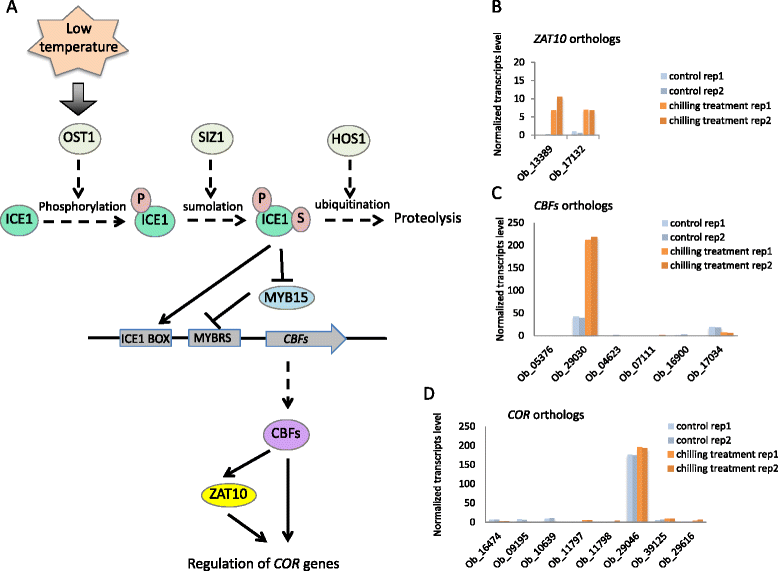De novo assembly and analysis of the transcriptome of Ocimum americanum var. pilosum under cold stress
- PMID: 26955811
- PMCID: PMC4784345
- DOI: 10.1186/s12864-016-2507-7
De novo assembly and analysis of the transcriptome of Ocimum americanum var. pilosum under cold stress
Abstract
Background: Ocimum americanum var. pilosum is a chilling-sensitive, widely distributed plant that is consumed as a vegetable in central and southern China. To increase our understanding of cold stress responses in this species, we performed de novo transcriptome assembly for O. americanum var. pilosum and compared the transcriptomes of plants grown under normal and low temperatures.
Results: A total of 115,022,842 high quality, clean reads were obtained from four libraries (two replicates of control samples and two replicates of chilling-treated samples) and were used to perform de novo transcriptome assembly. After isoforms were considered, 42,816 unigenes were generated, 30,748 of which were similar to known proteins as determined by a BLASTx search (E-value < =1.0E-05) against NCBI non-redundant, Swiss-Prot, Gene Ontology, KEGG, and Cluster of COG databases. Comparative analysis of transcriptomes revealed that 5179 unigenes were differentially expressed (with at least 2-fold changes, FDR < 0.01) in chilling-treated samples, and that 2344 and 2835 unigenes were up- and down-regulated by chilling stress, respectively. Expression of the 10 most up-regulated and the five most down-regulated unigenes was validated by qRT-PCR. To increase our understanding of these differentially expressed unigenes, we performed Gene ontology and KEGG pathway enrichment analyses. The CBF-mediated transcriptional cascade, a well-known cold tolerance pathway, was reconstructed using our de novo assembled transcriptome.
Conclusion: Our study has generated a genome-wide transcript profile of O. americanum var. pilosum and a de novo assembled transcriptome, which can be used to characterize genes related to diverse biological processes. This is the first study to assess the cold-responsive transcriptome in an Ocimum species. Our results suggest that cold temperature significantly affects genes related to protein translation and cellular metabolism in this chilling sensitive species. Although most of the CBF pathway genes have orthologs in O. americanum var. pilosum, none of the identified cold responsive (COR) gene orthologs was induced by cold, which is consistent with the lack of cold tolerance in this plant.
Figures







Similar articles
-
De novo transcriptome sequencing and gene expression profiling of Magnolia wufengensis in response to cold stress.BMC Plant Biol. 2019 Jul 18;19(1):321. doi: 10.1186/s12870-019-1933-5. BMC Plant Biol. 2019. PMID: 31319815 Free PMC article.
-
Transcriptome Profiling of Two Asparagus Bean (Vigna unguiculata subsp. sesquipedalis) Cultivars Differing in Chilling Tolerance under Cold Stress.PLoS One. 2016 Mar 8;11(3):e0151105. doi: 10.1371/journal.pone.0151105. eCollection 2016. PLoS One. 2016. PMID: 26954786 Free PMC article.
-
Transcriptome analysis of chrysanthemum (Dendranthema grandiflorum) in response to low temperature stress.BMC Genomics. 2018 May 2;19(1):319. doi: 10.1186/s12864-018-4706-x. BMC Genomics. 2018. PMID: 29720105 Free PMC article.
-
RNA Regulation in Plant Cold Stress Response.Adv Exp Med Biol. 2018;1081:23-44. doi: 10.1007/978-981-13-1244-1_2. Adv Exp Med Biol. 2018. PMID: 30288702 Review.
-
Low-temperature tolerance in land plants: Are transcript and membrane responses conserved?Plant Sci. 2018 Nov;276:73-86. doi: 10.1016/j.plantsci.2018.08.002. Epub 2018 Aug 7. Plant Sci. 2018. PMID: 30348330 Review.
Cited by
-
Transcriptome profiling of rubber tree (Hevea brasiliensis) discovers candidate regulators of the cold stress response.Genes Genomics. 2018 Nov;40(11):1181-1197. doi: 10.1007/s13258-018-0681-5. Epub 2018 Mar 6. Genes Genomics. 2018. PMID: 30315521
-
Preharvest and postharvest techniques that optimize the shelf life of fresh basil (Ocimum basilicum L.): a review.Front Plant Sci. 2023 Sep 8;14:1237577. doi: 10.3389/fpls.2023.1237577. eCollection 2023. Front Plant Sci. 2023. PMID: 37745993 Free PMC article. Review.
-
Plant Glycine-Rich Proteins in Stress Response: An Emerging, Still Prospective Story.Front Plant Sci. 2018 Mar 8;9:302. doi: 10.3389/fpls.2018.00302. eCollection 2018. Front Plant Sci. 2018. PMID: 29568308 Free PMC article. Review.
-
A glance at the chemodiversity of Ocimum species: Trends, implications, and strategies for the quality and yield improvement of essential oil.Phytochem Rev. 2022;21(3):879-913. doi: 10.1007/s11101-021-09767-z. Epub 2021 Aug 2. Phytochem Rev. 2022. PMID: 34366748 Free PMC article. Review.
-
Starch content differences between two sweet potato accessions are associated with specific changes in gene expression.Funct Integr Genomics. 2018 Nov;18(6):613-625. doi: 10.1007/s10142-018-0611-2. Epub 2018 May 12. Funct Integr Genomics. 2018. PMID: 29754269
References
-
- Yamada AN, Grespan R, Yamada ÁT, Silva EL, Silva-Filho SE, Damião MJ, de Oliveira Dalalio MM, Bersani-Amado CA, Cuman RKN. Anti-inflammatory activity of Ocimum americanum L. essential oil in experimental model of zymosan-induced arthritis. Am J Chin Med. 2013;41(4):913–926. doi: 10.1142/S0192415X13500614. - DOI - PubMed
-
- Bayala B, Bassole IHN, Gnoula C, Nebie R, Yonli A, Morel L, Figueredo G, Nikiema J-B, Lobaccaro JMA, Simpore J. Chemical composition, antioxidant, anti-inflammatory and anti-proliferative activities of essential oils of plants from burkina faso. PLoS One. 2014;9(3) doi: 10.1371/journal.pone.0092122. - DOI - PMC - PubMed
-
- Thaweboon S, Thaweboon B. In vitro antimicrobial activity of Ocimum americanum L. essential oil against oral microorganisms. Southeast Asian J Trop Med Public Health. 2009;40(5):1025–1033. - PubMed
-
- Upadhyay AK, Chacko AR, Gandhimathi A, Ghosh P, Harini K, Joseph AP, Joshi AG, Karpe SD, Kaushik S, Kuravadi N, Lingu CS, Mahita J, Malarini R, Malhotra S, Malini M, Mathew OK, Mutt E, Naika M, Nitish S, Pasha SN, Raghavender US, Rajamani A, Shilpa S, Shingate PN, Singh HR, Sukhwal A, Sunitha MS, Sumathi M, Ramaswamy S, Gowda M, et al. Genome sequencing of herb Tulsi (Ocimum tenuiflorum) unravels key genes behind its strong medicinal properties. BMC Plant Biol. 2015;15:212. doi: 10.1186/s12870-015-0562-x. - DOI - PMC - PubMed
Publication types
MeSH terms
Substances
LinkOut - more resources
Full Text Sources
Other Literature Sources

